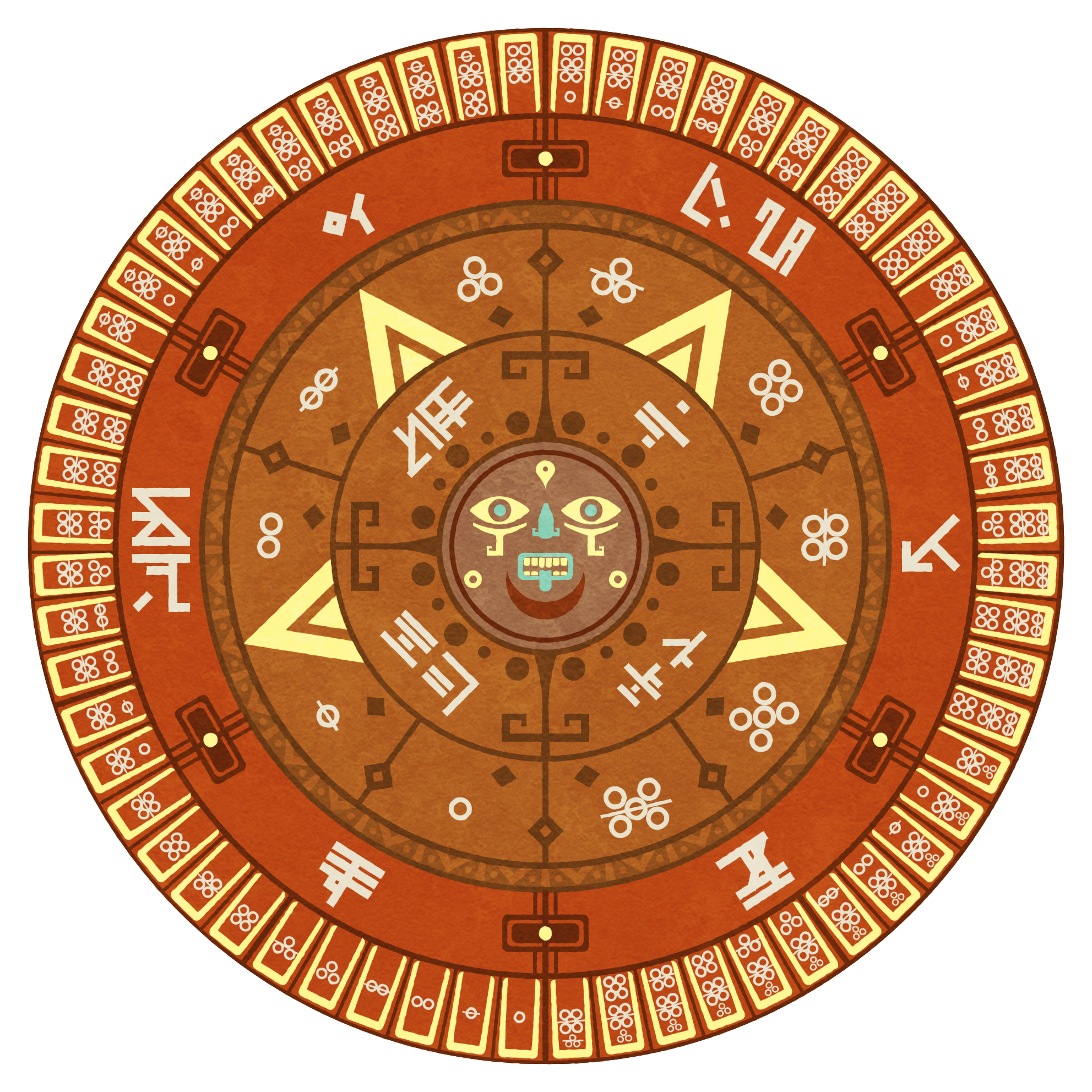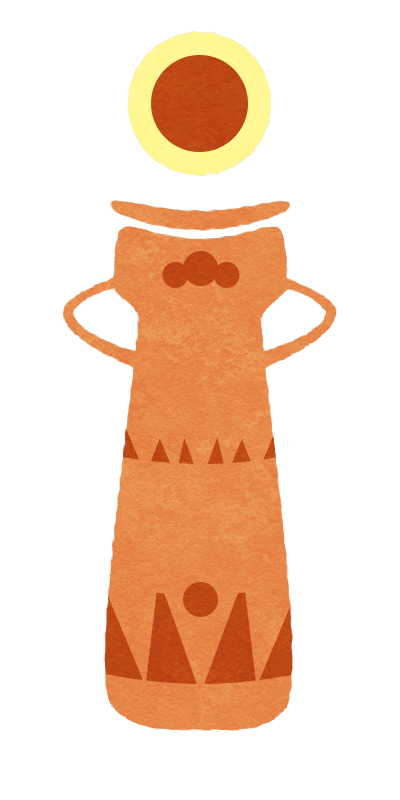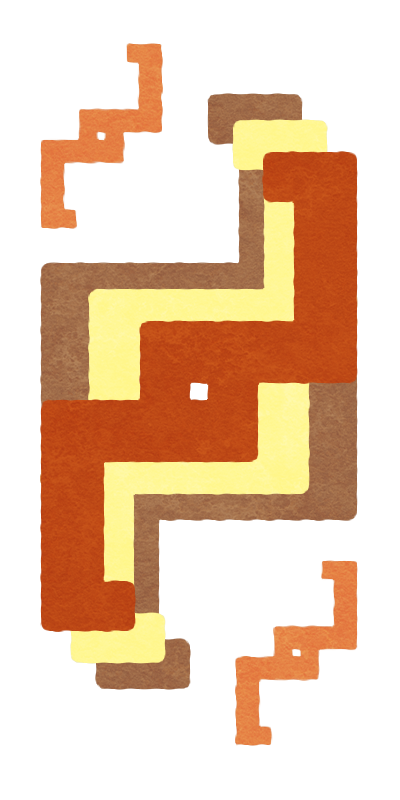The Yilqet Calendar
Popularized through the spread of Rektouzk's influence, the Yilqet calendar is used throughout most of Qet. As it is based on the movements of the stars and the celestial bodies of Qet similar calendars have been created by a number of separate groups— making its adoption all the easier.
The Yilqet calendar is circular, and separated into four rings. In truth, it consists of two different calendars— the Yat and the Nek, or the Solar and Celestial. The Yat— the Solar calendar— occupies the two outermost rings, and is based on the movements and coloration of Yilek (the sun) and the resulting seasons. The two inner rings are used for the Nek— the Celestial calendar— which is based on the movements of the stars and other distant bodies above.
Hotyixok: Season of rain. ~Three months. Rainfall is more common during this period, towards its end hurricanes and other storms form.
Hotchalit: Season of heat. ~Two months. Sparser rains, higher temperatures.
Hotyezil: Season of wind. ~One month. Rain picks up again, but so too does the wind— cooling many areas. In some places, terrible windstorms form. The length of these vary greatly from region to region, and invert once one crosses Qet's equator— as the Yilqet calendar was created in Rektouzk it most closely reflects their seasons. Though it is not too difficult for those in other regions to simply track the differing times at which their seasons occur, they won't be as precisely aligned to the months of the calendar.
Ziyl: It is believed that Ziyl is a period of prosperity. Hurricanes dramatically decrease during this period, for unknown reasons.
Nouzik: Xolik appears to split in two during this period, human birth rates are increased, and twins hear strange whispers.
Yek: Yek is seen as a period of misfortune— as the birth rates of monsters appears to increase. This also happens to be when the Kilyounchlez has left the night sky.
Nokixik: The stars are clearer at night, allowing those at sea to navigate more easily— increasing speed of travel and often allowing for discovery. Once a full year is complete, it is not added to a total count like in the Yat— simply, the year restarts. A clean slate.
As We Turn
Yat
The Yat is used for day-to-day life, farming, and trade, as it follows the seasons and weather patterns with them. A year has passed once the seasons loop around again. The Yat is separated into six months— which neatly approximate the varying lengths of the seasons. Each month consists of sixty days separated into six-day weeks. Sixty days are placed in the outermost ring, separated into ten weeks, and the six months are placed in the inner ring. The days of the week are as follows; Heyot, Texyot, Ziyot, Polyot, Chleyot, Litzyot. Months are named as follows; Pilex, Kontux, Poul, Yeqix, Qelyin, Xeyk.The seasons
There are only three seasons in Qet:Hotyixok: Season of rain. ~Three months. Rainfall is more common during this period, towards its end hurricanes and other storms form.
Hotchalit: Season of heat. ~Two months. Sparser rains, higher temperatures.
Hotyezil: Season of wind. ~One month. Rain picks up again, but so too does the wind— cooling many areas. In some places, terrible windstorms form. The length of these vary greatly from region to region, and invert once one crosses Qet's equator— as the Yilqet calendar was created in Rektouzk it most closely reflects their seasons. Though it is not too difficult for those in other regions to simply track the differing times at which their seasons occur, they won't be as precisely aligned to the months of the calendar.
Nek
The Nek is used for ceremonies, religious and other holidays, and tracks a handful of events that coincide with the movement of far-off objects in the night sky. A year has passed once the bright star Xolik has aligned once more with the Kilyounchlez or Sky Snake— a great nebula in the distance that slithers through the night sky, disappearing periodically. The Nek is organized into four months, and ten days. Ten days are tracked in the outer ring, and four months in the inner. Each day is approximately a single Yat year, making a Nek year— known as a Nekeux— about forty Yat years in length. The ten days are as follows: Toukol, Tuzkol, Yetkol, Nokol, Zityikol, Kexkol, Tzetkol, Calkol, Lozkol, Kolkol. Each is believed to correspond to prosperity and misfortune in different aspects, such as crop yield or love, and can have effects on one's life depending on which they are born in. The four months are named:Ziyl: It is believed that Ziyl is a period of prosperity. Hurricanes dramatically decrease during this period, for unknown reasons.
Nouzik: Xolik appears to split in two during this period, human birth rates are increased, and twins hear strange whispers.
Yek: Yek is seen as a period of misfortune— as the birth rates of monsters appears to increase. This also happens to be when the Kilyounchlez has left the night sky.
Nokixik: The stars are clearer at night, allowing those at sea to navigate more easily— increasing speed of travel and often allowing for discovery. Once a full year is complete, it is not added to a total count like in the Yat— simply, the year restarts. A clean slate.
You can view the Nek here,
With all this said, a full day is written first with its Yat date, followed by its Nek date. For example: 2/4/2451/9/4 is the second day of Yeqix in the year 2451, on the Lozkol of Yek.Yihl-ket
Intersection
There are holidays that occur neither on the Yat nor the Nek— but when certain periods between them intersect. When the Nek month of Ziyl occurs, the Hontualieu Day of No Rain is skipped. Similarly, the Lliaqeu Exam Week becomes more difficult when it intersects with Ziyl— as it is believed to give students an unfair advantage that must be compensated for. When the Nek Day of Renewal occurs, and intersects with a Klix Niktatuez, the holiday of Likex is observed and celebrated. During Likex, many will forgo sleep, and hold feasts under the brightened moon above. Rounded clay lanterns made to mimic the fractured satellite's features are lit, and kept outside. It is believed that with this bright, fully-lit moon, the way forward is lit for a better future.When the Nek Day of Preparing comes around, extra precaution is taken around Hotyixok— to ensure that the damage done by storms will not mean a slow death in the following years. Similarly, when the Nek Dark Day occurs, ships will seldom leave port during Hotyixok in fear that the worst storms form during this time.
Monthly Changes
People react differently to the Net months. In Ziyl, preparations and caution towards storms are lessened. During Nouzik— as some cultures hold stigma and superstition towards twins— will either swear celibacy, or commit infanticide should they give birth to twins. Others, such as the Ponouli welcome the higher birth rates, wishing to usher in as many into their families as they are able. Most will curb their birthrates during Yek— fearing that children born during this period are destined for misfortune. Especially if they are born on the Dark Day. Patrols are increased, and military forces are commonly seen along the outskirts of settlements— ready to defend against the increased monster activity. Mercenaries and thrill seekers find this period particularly enjoyable.During the Nek month of Nokixik, many nations and hopefuls alike will set out to see in search of new lands— or forgotten and rumored artifacts. Tourism typically increases during this period, making it a both a boon and a curse— depending on who you ask.
Related articles
Remove these ads. Join the Worldbuilders Guild






I can tell you put a lit of thought into this. I love the unique idea of two concurrent calendars and all the different ways they may interact. I love it!
Necromancy is a Wholesome Science.
Thank you! A lot of the ancient Mesoamerican calendars (including the more well known Mayan calendar) use concurrent calendars like this, which is where the idea came from.